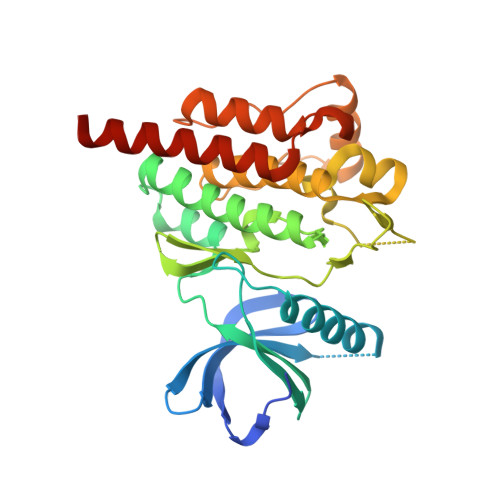Structural insights for design of potent spleen tyrosine kinase inhibitors from crystallographic analysis of three inhibitor complexes.
Villasenor, A.G., Kondru, R., Ho, H., Wang, S., Papp, E., Shaw, D., Barnett, J.W., Browner, M.F., Kuglstatter, A.(2009) Chem Biol Drug Des 73: 466-470
- PubMed: 19220318
- DOI: https://doi.org/10.1111/j.1747-0285.2009.00785.x
- Primary Citation of Related Structures:
3FQE, 3FQH, 3FQS - PubMed Abstract:
Spleen tyrosine kinase is considered an attractive drug target for the treatment of allergic and antibody mediated autoimmune diseases. We have determined the co-crystal structures of spleen tyrosine kinase complexed with three known inhibitors: YM193306, a 7-azaindole derivative and R406. The cis-cyclohexyldiamino moiety of YM193306 is forming four hydrophobically shielded polar interactions with the spleen tyrosine kinase protein and is therefore crucial for the high potency of this inhibitor. Its primary amino group is inducing a conformational change of the spleen tyrosine kinase DFG Asp side chain. The crystal structure of the 7-azaindole derivative bound to spleen tyrosine kinase is the first demonstration of a 2-substituted 7-azaindole bound to a protein kinase. Its indole-amide substituent is tightly packed between the N- and C-terminal kinase lobes. The co-crystal structure of the spleen tyrosine kinase-R406 complex shows two main differences to the previously reported structure of spleen tyrosine kinase soaked with R406: (i) the side chain of the highly conserved Lys is disordered and not forming a hydrogen bond to R406 and (ii) the DFG Asp side chain is pointing away from and not towards R406. The novel protein-ligand interactions and protein conformational changes revealed in these structures guide the rational design and structure-based optimization of second-generation spleen tyrosine kinase inhibitors.















